20141025雅思考试阅读考题回顾
- 格式:doc
- 大小:327.50 KB
- 文档页数:8
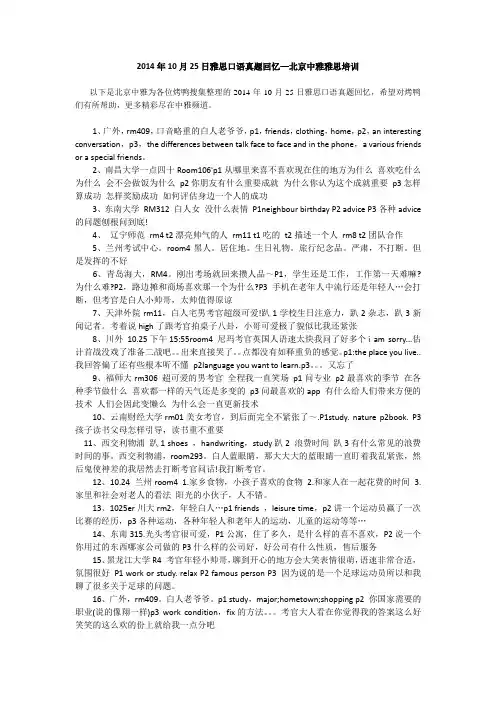
2014年10月25日雅思口语真题回忆—北京中雅雅思培训以下是北京中雅为各位烤鸭搜集整理的2014年10月25日雅思口语真题回忆,希望对烤鸭们有所帮助,更多精彩尽在中雅频道。
1、广外,rm409,口音略重的白人老爷爷,p1,friends,clothing,home,p2,an interesting conversation,p3,the differences between talk face to face and in the phone,a various friends or a special friends。
2、南昌大学一点四十Room106'p1从哪里来喜不喜欢现在住的地方为什么喜欢吃什么为什么会不会做饭为什么p2你朋友有什么重要成就为什么你认为这个成就重要p3怎样算成功怎样奖励成功如何评估身边一个人的成功3、东南大学RM312 白人女没什么表情P1neighbour birthday P2 advice P3各种advice 的问题刨根问到底!4、辽宁师范rm4 t2漂亮帅气的人rm11 t1吃的t2描述一个人rm8 t2团队合作5、兰州考试中心。
room4黑人。
居住地。
生日礼物。
旅行纪念品。
严肃,不打断。
但是发挥的不好6、青岛海大,RM4。
刚出考场就回来攒人品~P1,学生还是工作,工作第一天难嘛?为什么难?P2,路边摊和商场喜欢那一个为什么?P3手机在老年人中流行还是年轻人…会打断,但考官是白人小帅哥,太帅值得原谅7、天津外院rm11,白人宅男考官超级可爱!趴1学校生日注意力,趴2杂志,趴3新闻记者。
考着说high了跟考官拍桌子八卦,小哥可爱极了貌似比我还紧张8、川外10.25下午15:55room4 尼玛考官英国人语速太快我问了好多个i am sorry...估计首战没戏了准备二战吧。
出来直接哭了。
点都没有如释重负的感觉。
p1:the place you live..我回答偏了还有些根本听不懂p2language you want to learn.p3。
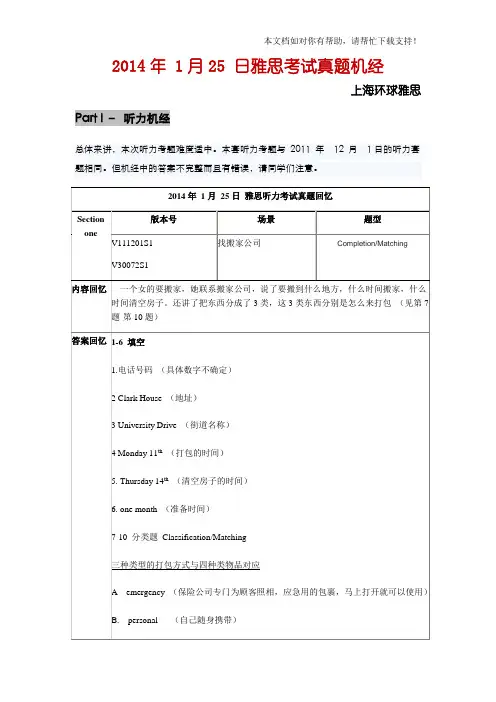
2014年 1月25 日雅思考试真题机经上海环球雅思Part I –听力机经总体来讲,本次听力考题难度适中。
本套听力考题与2011 年12 月1日的听力套题相同。
但机经中的答案不完整而且有错误,请同学们注意。
Part II–阅读机经总体来讲,本次阅读难度适中,两旧一新。
本次雅思考试涉及到的题型有(T/F/NG,Multiple choices, Matching,List of Headings,Sentence completion,其中判断题比重比较大)。
建议烤鸭们平时多练习高频题型。
to psychologist Gerald Jellison of the University of South California, are lied to about 200 times a day, roughly one untruth every five minutes--often deceive for exactly the same reasons: to save their own skins or to get something they can't get by other means.But knowing how to catch deceit can be just as important a survival skill as knowing how to tell a lie and get away with it. A person able to spot falsehood quickly is unlikely to be swindled by an unscrupulous business associate or hoodwinked by a devious spouse. Luckily, nature provides more than enough clues to trap dissemblers in their own tangled webs--if you know where to look. By closely observing facial expressions, body language and tone of voice, practically anyone can recognize the telltale signs of lying. Researchers are even programming computers--like those used on Lie Detector--to get at the truth by analyzing the same physical cues available to the naked eye and ear. "With the proper training, many people can learn to reliably detect lies," says Paul Ekman, professor of psychology at the University of California, San Francisco, who has spent the past 15 years studying the secret art of deception.In order to know what kind of lies work best, successful liars need to accurately assess other people's emotional states. Ekman's research shows that this same emotional intelligence is essential for good lie detectors, too. The emotional state to watch out for is stress, the conflict most liars feel between the truth and what they actually say and do.Even high-tech lie detectors don't detect lies as such; they merely detect the physical cues of emotions, which may or may not correspond to what the person being tested is saying. Polygraphs, for instance, measure respiration, heart rate and skin conductivity, which tend to increase when people are nervous--as they usually are when lying. Nervous people typically perspire, and the salts contained in perspiration conduct electricity. That's why a sudden leap in skin conductivity indicates nervousness--about gettingcaught, perhaps?--which might, in turn, suggest that someone is being economical with the truth. On the other hand, it might also mean that the lights in the television studio are too hot--which is one reason polygraph tests are inadmissible in court. "Good lie detectors don't rely on a single sign," Ekman says, "but interpret clusters of verbal and nonverbal clues that suggest someone might be lying."Those clues are written all over the face. Because the musculature of the face is directly connected to the areas of the brain that process emotion, the countenance can be a window to the soul. Neurological studies even suggest that genuine emotions travel different pathways through the brain than insincere ones. If a patient paralyzed by stroke on one side of the face, for example, is asked to smile deliberately, only the mobile side of the mouth is raised. But tell that same person a funny joke, and the patient breaks into a full and spontaneous smile. Very few people--most notably, actors and politicians--are able to consciously control all of their facial expressions. Lies can often be caught when the liar's true feelings briefly leak through the mask of deception. "We don't think before we feel," Ekman says. "Expressions tend to show up on the face before we're even conscious of experiencing an emotion."One of the most difficult facial expressions to fake--or conceal, if it is genuinely felt--is sadness. When someone is truly sad, the forehead wrinkles with grief and the inner corners of the eyebrows are pulled up. Fewer than 15% of the people Ekman tested were able to produce this eyebrow movement voluntarily. By contrast, the lowering of the eyebrows associated with an angry scowl can be replicated at will by almost everybody. "If someone claims they are sad and the inner corners of their eyebrows don't go up," Ekman says, "the sadness is probably false."The smile, on the other hand, is one of the easiest facial expressions to counterfeit. It takes just two muscles--the zygomaticus major muscles thatPart III –写作机经本次小作文为饼状图,难度不大。
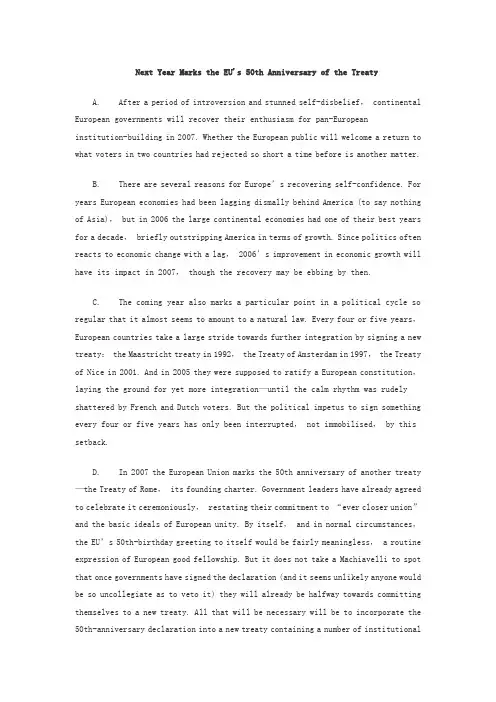
Next Year Marks the EU's 50th Anniversary of the TreatyA. After a period of introversion and stunned self-disbelief, continental European governments will recover their enthusiasm for pan-Europeaninstitution-building in 2007. Whether the European public will welcome a return to what voters in two countries had rejected so short a time before is another matter.B. There are several reasons for Europe’s recovering self-confidence. For years European economies had been lagging dismally behind America (to say nothing of Asia), but in 2006 the large continental economies had one of their best years for a decade, briefly outstripping America in terms of growth. Since politics often reacts to economic change with a lag, 2006’s improvement in economic growth will have its impact in 2007, though the recovery may be ebbing by then.C. The coming year also marks a particular point in a political cycle so regular that it almost seems to amount to a natural law. Every four or five years,European countries take a large stride towards further integration by signing a new treaty: the Maastricht treaty in 1992, the Treaty of Amsterdam in 1997, the Treaty of Nice in 2001. And in 2005 they were supposed to ratify a European constitution,laying the ground for yet more integration—until the calm rhythm was rudely shattered by French and Dutch voters. But the political impetus to sign something every four or five years has only been interrupted, not immobilised, by this setback.D. In 2007 the European Union marks the 50th anniversary of another treaty —the Treaty of Rome, its founding charter. Government leaders have already agreed to celebrate it ceremoniously, restating their commitment to “ever closer union”and the basic ideals of European unity. By itself, and in normal circumstances,the EU’s 50th-birthday greeting to itself would be fairly meaningless, a routine expression of European good fellowship. But it does not take a Machiavelli to spot that once governments have signed the declaration (and it seems unlikely anyone would be so uncollegiate as to veto it) they will already be halfway towards committing themselves to a new treaty. All that will be necessary will be to incorporate the 50th-anniversary declaration into a new treaty containing a number of institutionaland other reforms extracted from the failed attempt at constitution-building and —hey presto—a new quasi-constitution will be ready.E. According to the German government—which holds the EU’s agenda-setting presidency during the first half of 2007—there will be a new draft of a slimmed-down constitution ready by the middle of the year, perhaps to put to voters, perhaps not. There would then be a couple of years in which it will be discussed, approved by parliaments and, perhaps, put to voters if that is deemed unavoidable. Then,according to bureaucratic planners in Brussels and Berlin, blithely ignoring the possibility of public rejection, the whole thing will be signed, sealed and a new constitution delivered in 2009-10. Europe will be nicely back on schedule. Its four-to-five-year cycle of integration will have missed only one beat.F. The resurrection of the European constitution will be made more likely in 2007 because of what is happening in national capitals. The European Union is not really an autonomous organisation. If it functions, it is because the leaders of the big continental countries want it to, reckoning that an active European policy will help them get done what they want to do in their own countries.G. That did not happen in 2005-06. Defensive, cynical and self-destructive,the leaders of the three largest euro-zone countries—France, Italy and Germany —were stumbling towards their unlamented ends. They saw no reason to pursue any sort of European policy and the EU, as a result, barely functioned. But by the middle of 2007 all three will have gone, and this fact alone will transform the European political landscape.H. The upshot is that the politics of the three large continental countries,bureaucratic momentum and the economics of recovery will all be aligned to give a push towards integration in 2007. That does not mean the momentum will be irresistible or even popular. The British government, for one, will almost certainly not want to go with the flow, beginning yet another chapter in the long history of confrontation between Britain and the rest of Europe. More important,the voters will want a say. They rejected the constitution in 2005. It would befoolish to assume they will accept it after 2007 just as a result of an artful bit of tinkering.Questions 1-6 Do the following statemets reflect the claims of the writer in Reading Passage 1?Write your answer in Boxes 1-6 on your answer sheet.TRUE if the statemenht reflets the claims of the writerFALSE if the statement contradicts the claims of the writerNOT GIVEN if it is possbile to say what the writer thinks about this1.After years’ introspection and mistrust, continental European governments will resurrect their enthusiasm for more integration in 2007.2. The European consitution was officially approved in 2005 in spite of the oppositon of French and Dutch voters.3. The Treaty of Rome , which is considered as the fundamental charter of the European Union, was signed in 1957.4.It is very unlikely that European countries will sign the declaration at the 50th anniversary of the Treaty of Rome.5.French government will hold the EU’s presidency and lay down the agenda during the first half of 2008.6.For a long time in hisotry, there has been confrontation between Britain and the rest of European countries.Questions 7-10 Complet the following sentencces.Choose NO MORE THAN THREE WORDS from Reading Passage 1 for each answer.Write your answer in Boxes 7-10 on your answer sheet.7. Every four or five years, European countries tend to make a rapid progress towards ___________________by signing a new treaty.8. The European constitution is supposed to ______________________for yet more integration of European Union member countries.9. The bureaucratic planners in Brussels and Berlin rashly ignore the possibility of __________________and think the new consitution will be delivered in 2009-10.10. The politics of the three large continental countries, __________________ and the economic recovery will join together to urge the integration in 2007.Questions 11-14 Choose the appropriate letters A-D and write them in boxes 11-14 on your answer sheet.11. Which of the following statemnts is true of Euopean economic development.A. The economy of Europe developed much faster than that of Asia before 2006.B. The growth of European economy was slightly slower than that of America in 2006.C. The development of European economy are likely to slow down by 2007.D. The recovery of European economy may be considerably accelerated by 2007.12. The word “immobilised” in the last line of Section C means ___________.A. stopped completely.B. pushed strongly.C. motivated wholely.D. impeded totally.13. Which of the following statements about the treaties in European countries is NOT TRUE.A. The Maastricht Treaty was signed in 1992.B. The Treaty of Amsterdan was signed in 1997.C. The Treaty of Nice was signed in 2001.D. The Treaty of Rome was signed in 2007.14. The European constitution failed to be ratified in 2005--2006, becauseA. The leaders of France, Italy and Germany were defensive, cynical and self-destructuve..B. The voters in two countries of the Union --France and Holland rejected the constitution.C. The leaders of the EU thought that it was unneccessary to pursue any European policy.D. France, Italy and Germany are the three largest and most influential euro-zone countries.Notes to the Reading Passage1. pan-Enropeanpan-:前缀:全,总,泛pan-African 全/泛非洲的(运动)pan-Enropean全/泛欧的(机构建设)2. outstrip超越,胜过,超过,优于Material development outstripped human development”“物质的发展超过了人类的进步”3. ebb回落跌落;衰退或消减The tide is on the ebb.正在退潮。
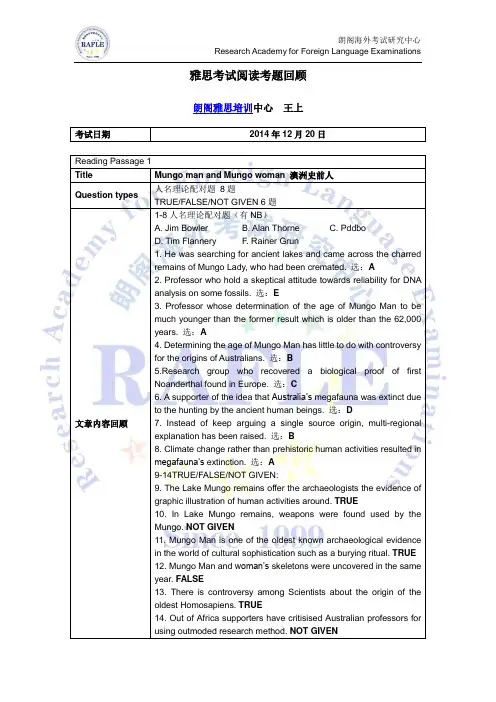

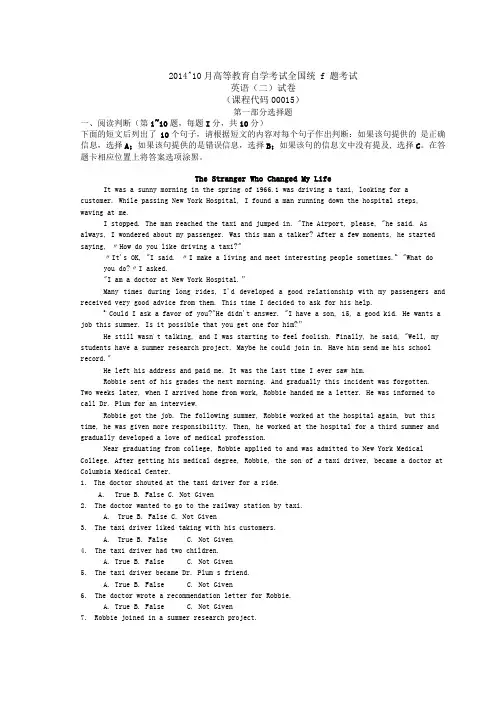
2014^10月高等教育自学考试全国统 f 题考试英语(二)试卷(课程代码00015)第一部分选择题一、阅读判断(第1~10题,每题I分,共10分)下面的短文后列出了10个句子,请根据短文的内容对每个句子作出判断:如果该句提供的是正确信息,选择A;如果该句提供的是错误信息,选择B;如果该句的信息文中没有提及, 选择C。
在答题卡相应位置上将答案选项涂黑。
The Stranger Who Changed My LifeIt was a sunny morning in the spring of 1966.1 was driving a taxi, looking for a customer. While passing New York Hospital, I found a man running down the hospital steps, waving at me.I stopped. The man reached the taxi and jumped in. "The Airport, please, "he said. As always, I wondered about my passenger. Was this man a talker? After a few moments, he started saying, 〃How do you like driving a taxi?"〃It's OK, "I said. 〃I make a living and meet interesting people sometimes.z,"What do you do?〃I asked."I am a doctor at New York Hospital.”Many times during long rides, I'd developed a good relationship with my passengers and received very good advice from them. This time I decided to ask for his help.z,Could I ask a favor of you?"He didn't answer. "I have a son, 15, a good kid. He wants a job this summer. Is it possible that you get one for him?”He still wasn,t talking, and I was starting to feel foolish. Finally, he said, "Well, my students have a summer research project. Maybe he could join in. Have him send me his school record."He left his address and paid me. It was the last time I ever saw him.Robbie sent of his grades the next morning. And gradually this incident was forgotten. Two weeks later, when I arrived home from work, Robbie handed me a letter. He was informed to call Dr. Plum for an interview.Robbie got the job. The following summer, Robbie worked at the hospital again, but this time, he was given more responsibility. Then, he worked at the hospital for a third summer and gradually developed a love of medical profession.Near graduating from college, Robbie applied to and was admitted to New York Medical College. After getting his medical degree, Robbie, the son of a taxi driver, became a doctor at Columbia Medical Center.1.The doctor shouted at the taxi driver for a ride.A.TrueB. FalseC. Not Given2.The doctor wanted to go to the railway station by taxi.A.TrueB. FalseC. Not Given3.The taxi driver liked taking with his customers.A.TrueB. FalseC. Not Given4.The taxi driver had two children.A. TrueB. FalseC. Not Given5.The taxi driver became Dr. Plum,s friend.A. TrueB. FalseC. Not Given6.The doctor wrote a recommendation letter for Robbie.A. TrueB. FalseC. Not Given7.Robbie joined in a summer research project.A. TrueB. FalseC. Not Given8. Robbie gradually got interested in medicine.A. TrueB. FalseC. Not Given9. Robbie finally became a doctor at New York HospitalA. TrueB. FalseC. Not Given10. Big opportunities can come out of ordinary meetings.A. TrueB. FalseC. Not Given二、阅读选择(第11~15题,每题2分,共10分)阅读下面短文,请从短文后所给各题的4个选项(A 、B 、C 、D )中选出1个最佳选项, 并在答题卡相应位置上将该项涂黑。
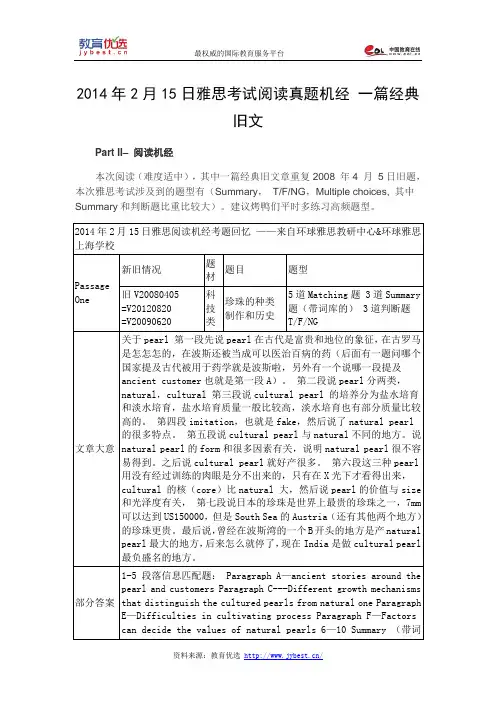
2014年2月15日雅思考试阅读真题机经一篇经典旧文Part II–阅读机经本次阅读(难度适中),其中一篇经典旧文章重复2008 年4 月5日旧题,本次雅思考试涉及到的题型有(Summary,T/F/NG,Multiple choices, 其中Summary和判断题比重比较大)。
建议烤鸭们平时多练习高频题型。
2014年2月15日雅思阅读机经考题回忆——来自环球雅思教研中心&环球雅思上海学校Passage One 新旧情况题材题目题型旧V20080405=V20120820=V20090620科技类珍珠的种类制作和历史5道Matching题 3道Summary题(带词库的) 3道判断题T/F/NG文章大意关于pearl 第一段先说pearl在古代是富贵和地位的象征,在古罗马是怎怎怎的,在波斯还被当成可以医治百病的药(后面有一题问哪个国家提及古代被用于药学就是波斯啦,另外有一个说哪一段提及ancient customer也就是第一段A)。
第二段说pearl分两类,natural,cultural 第三段说cultural pearl 的培养分为盐水培育和淡水培育,盐水培育质量一般比较高,淡水培育也有部分质量比较高的。
第四段imitation,也就是fake,然后说了natural pearl的很多特点。
第五段说cultural pearl与natural不同的地方。
说natural pearl的form和很多因素有关,说明natural pearl很不容易得到。
之后说cultural pearl就好产很多。
第六段这三种pearl 用没有经过训练的肉眼是分不出来的,只有在X光下才看得出来,cultural 的核(core)比natural 大,然后说pearl的价值与size 和光泽度有关,第七段说日本的珍珠是世界上最贵的珍珠之一,7mm 可以达到US150000,但是South Sea的Austria(还有其他两个地方)的珍珠更贵。